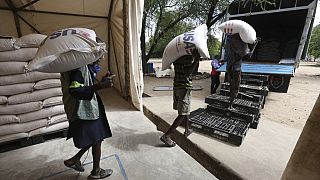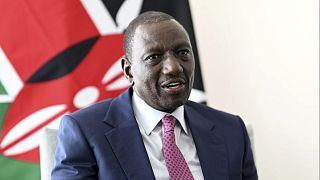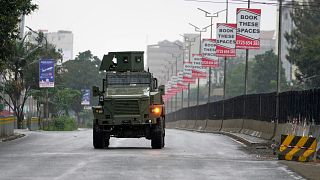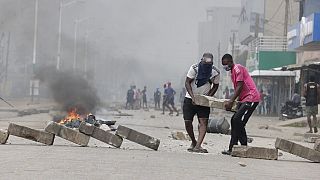Kenya
With urbanisation, Kenya's capital population has grown rapidly, doubling over the last 20 years. In 2019, nearly 4.5 million people lived in Nairobi.
This population density means that buildings have been built very close to each other. For this supermarket manager, it's a problem.
"The building is quite big and we have to use the electricity throughout the day because we can not manage to do anything here without the lights. So when the power is out, we opt to turn on the generator because that is the immediate alternative that we have and we can't use the solar panels because the building here is much congested," says Samuel Mburu.
Over-population has led to the creation of many new satellite neighbourhoods that sprawl around the capital with very little planning or regulation. The density of buildings means natural light struggles to reach residents -- who have to turn on the lights most of the day.
"Here where I live, there is a problem with light, even if you open the window it does not let the light in because of the congestion. There is a problem when it rains because we don't collect rainwater, we use borehole water and there is a problem with sewage," says Angela Mutuku, a Nairobi resident.
Rainwater is left to run down the streets, causing floods and overwhelming sewage systems. One of the solutions being considered is to build satellite cities from scratch, with the environment in mind.
One such project already under construction is Konza Technopolis.
Just 64 kilometres (40 miles) south of Nairobithe upcoming smart city is supported by the Kenyan government with architectural designs that factor in rainwater collection and utilisation, as well as use of solar power.
According to the developers, affordable residential homes, universities and student accommodation will be built in the new city as well as commercial buildings, technology hubs, offices, hotels and entertainment centres.
The city will occupy 5,000 acres and will be developed in four phases. Phase one - covering 400 acres - is estimated to create 12,960 residential units housing about 30,000 residents.
Developers say the housing project will cater for both ends of the market through provision of affordable housing units, although the majority will be targeted towards professional middle-income families.
For sustainability, construction materials used in the city must be green with low embodied energy. The technopolis has set aside green spaces and adopts green building practices geared at reducing greenhouse gas emissions within the city and ensuring a clean environment, sustainable use of water, clean, efficient and renewable energy, clean sanitation and waste management.
Announced in 2008, the city was expected to be completed by 2019. According to promotional material still available on its website it was set to contribute $1.3 billion to Kenya's GDP by 2020.
Running behind schedule, the developers of the project are not losing hope, and are going all in on eco-friendly features.
This building features double-glazed windows, solar panels, smart lighting, sensored toilet flushes and rainwater collection.
"For ensuring that water is consumed adequately, we ensure that the buildings are designed with sensors in the flushing of toilets and also in the washing of hands. For this, we also encourage water harvesting especially during rainy seasons we have storage tanks under there so that you can pump them up and they can be used for flushing of toilets," explains Beryl Omollo, environmental and sustainability officer, Konza Technopolis.
The developers are fully aware of the environmental cost of building these offices and encourage to source as many materials as possible locally.
"In construction, there is so much material that are produced in terms of waste, I can give you an example, there is a lot of timber that is used for shuttering for use for construction of scaffold. Our approach to ensure that is sustainable, we have multiple use of a simple resource such as timber. So that rather than using it for a single use, it is reused for a different application as mentioned. In doing so, you find that we do not have to go and cut additional trees for different applications of timber used in construction. Other waste that is generated at Konza is segregated primarily for recycling," says Antony Sang, engineer and chief manager of construction operations, Konza Technopolis.
Real estate contributes up to 30 percent of global greenhouse gas emissions according to the United Nations Environmental Programme.
"We look at the building through its entire life cycle from the design, construction, to the use of the building and the demolition," says Nickson Otieno, architect and environmental design consultant, Niko Green.
"All those phases of the development of the built environment have an impact on the environment. So we are looking at the impacts serrated to extraction of materials, manufacturing, transporting these materials and putting them up in the building. They contribute to environmental degradation if not properly managed and we use a lot of energy to be able to extract, process materials and use them in the building. And depending on which type of energy is used that energy used in the processing of materials and construction contributes significantly to climate change."
The Kenyan government allocated $73,840,680 this financial year (2022) towards the development of Konza city. The project also received a $6 million grant from South Korea in March to help fund the Kenya Advanced Institute of Science and Technology (KAIST) planned for the site.
Neighbourhoods like Konza which are planned from the outset to allow for energy efficiency, space and quality of life are very rare, but the Kenya government says it wants to build more.












01:01
Kenya: Visa-free travel now available for many African and Caribbean countries
00:22
Boniface Kariuki, a Kenyan mask vendor shot at close range laid to rest
11:17
Bridging the legal gap in Africa’s digital boom {Business Africa}
Go to video
First Malaria treatment for babies approved
Go to video
AI videos falsely show Kenyan President resigning following deadly protests
02:16
Kenya's William Ruto faces growing discontent over economy and police brutality